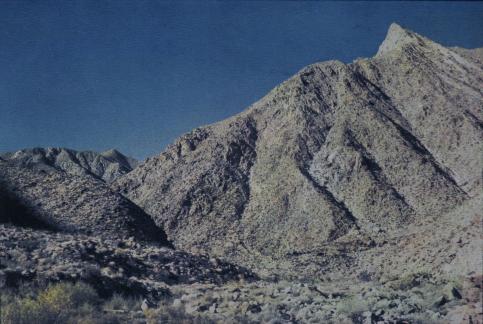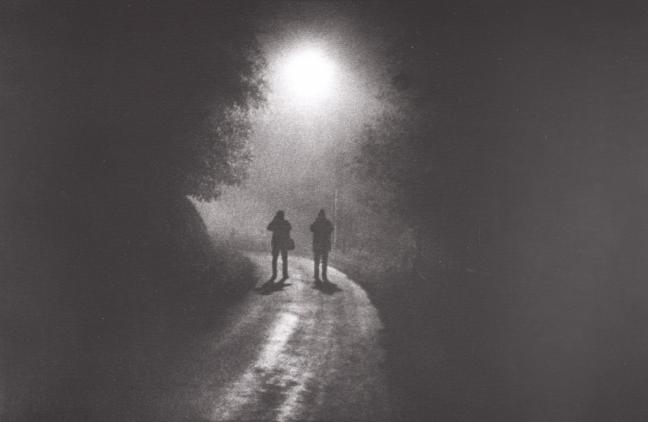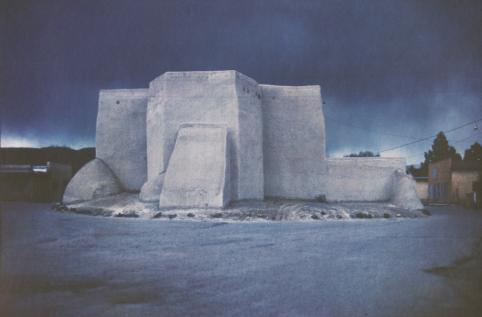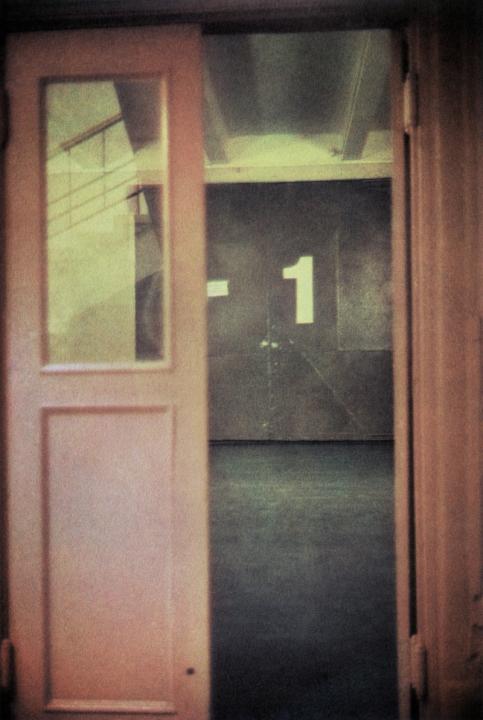Apart from a few exceptions [Sudre, Brihat, Cordier], the work of a photographer involves taking a shot and then printing it. From Nicéphore Niépce onwards, the photographer traditionally made their own prints, in a dedicated room or in their bathroom or kitchen adapted for the occasion. This stage of the process was soon to be taken over by industry, mainly on the initiative of the Kodak company, as their advertising proclaimed “You press the button, we do the rest”. Later on, photographic agencies always contracted out the printing process for the press and photographers used outside laboratories. Sometimes this was because they did not think the process was that important, sometimes they simply did not have the time, and sometimes, the printers managed to gain their trust.
In the case of the latter, many photographers consider that those most likely to understand their approach and to use this crucial stage to reveal their intentions better than the photographers themselves are other exceptional craftspeople. The resulting pairings can be quite exclusive. Some photographers swear by one printer alone and would never dream of working with anyone else. The old guard, Yvon Le Marlec, Claudine Sudre, Philippe Salaün and Roland Dufau [for colour], and the current batch, Guillaume Geneste, Thomas Consanti, Diamantino… have played an essential role in photography over the past fifty years, for anyone who thinks the development and printing processes are an integral part of the work of any photographer. The name Fresson stands out in the gallery of printers, with three first names: Pierre, Michel and Jean-François. This dynasty of printers is still going strong, under the aegis of Jean-François Fresson who is keeping up the traditional family printing method [most often in colour], that was originally developed by Pierre and Michel Fresson.
Today, the Fressons continueto work using a technical process that has practically disappeared, that of pigment-based prints. In 1832, Gustav Suchow revealed that light had an effect on chromates; in 1852, William Henry Fox Talbot [1800-1877] showed that a solution of gelatine and potassium dichromate hardened after exposure to light, known as his “salted paper” process; in 1855, Louis Alphonse Poitevin [1819-1882] used this discovery to create a process using charcoal by mixing potassium dichromate and carbon black to produce “carbon prints”. The pigment process and its offshoots [other pigments can be used besides carbon black] were more resistant than the silver-based processes and became a booming market at the end of the 19 th century. These pigment processes provided photographers with multiple creative possibilities, different from traditional silver processes. Many photographers and photographic paper manufacturers contributed to making the various processes work, making them popular among, in particular, photographers from the pictorialism movement at the turn of the 20 th century.
It was in this context of effervescence around pigment processes that the Fresson adventure began, when Théodore-Henri Fresson [1865-1951] developed his own pigment process and presented it to the Société Française de
Photographie
in 1899. His “satin carbon” process led to the success of the family business until demand for their services declined in the mid twentieth century. From 1947 onwards, sales of “satin carbon” paper dropped and the business pivoted into developing and printing for professional photographers, such as Laure Albin Guillot and Lucien Lorelle. From 1950 onwards, Pierre [1904-1983], one of Théodore-Henri Fresson’s two children, with help from his own son Michel [1936-2020], began working to adapt the family’s process to colour photography. When they moved to Savignysur- Orge in 1952, Pierre and Michel Fresson launched their colour print business using a technique of their own invention, the famous Fresson process, and Jean-François joined the business in 1978.
The final print is obtained by separating a colour original through three filters [red, green, blue] then exposing to the light the four colours one after the other [cyan, yellow, magenta and black], before a bath of warm water and fine, slightly abrasive sawdust. The print is the result of a complex, perfectly mastered technique and unique know-how, in a workshop where the technicians are acutely aware at all times of the temperature and humidity levels.
Producing a Fresson print is a complex process, that requires both impeccable technique [the application of the successive layers on the paper is done by a special machine that was designed and built by the Fressons themselves in 1952 and is still in use today] and a sharp-eyed printer in perfect control of their environment. Accidents happen all the time during the process, in particular when the heavy paper rips as it is being taken out of the bath, inevitably bringing tension into the printer’s shoulders as they are obliged to start all over again! It can take between two and five days to make one print, and the result is immediately recognisable. They are soft, smooth, warm, sensual, slightly blurred and almost grainy despite the smooth paper and often small formats [the most common format is 21 x 27 cm].
Everyone loves this aesthetic. It can transform mediocre shots into “great photographs” whose charm comes from the inherently unique atmosphere created by the process. This assertion holds true for all printers and furthermore, a really good printer is one that can extract the very best from a negative. In addition, the Fresson process is the last remaining example of pictorialism, an old artistic movement where technique and aesthetic stood out from amateur and vernacular photography.
Other photographers, such as Bernard Plossu and his friends swear by the Fresson Process. Indeed, the Fressons are experts in magnifying images, the way they layer murkiness, accentuate already “perfect” framing adds [or indeed creates] meaning in an otherwise banal shot. Bernard Plossu recognised that the Fressons have a certain skill in making photographs look better. His photographs of perfectlyframed, real-life, anecdotal details, far from being tableaux, took on new meaning thanks to the Fresson process, giving the viewer the impression that they can feel what the photographer felt when the shot was taken. When printed by the Fressons, Bernard Plossu’s photographs become impressionist compositions where the muted colours invite examination and introspection, their small size reinforcing this immersive feel. Plossu’s photographs are so in tune with the Fresson process, you could be forgiven for thinking that it was invented just for him. Plossu’s name has been associated with his printer’s since 1967 when Plossu first discovered the process, and he, in turn has been the best possible representative for the Savigny-sur-Orge based business. Furthermore, since early 1970, Plossu has regularly visited the workshop, documenting the family dynasty at work.
While the Fresson Process and Bernard Plossu’s photography developed a mutually beneficial relationship, he was by no means the only photographer to use their services. Over the years, he built up a “family”, the common denominators of which were walking, wandering, photography and the Fresson process. This show brings a few members of this vast family together with Bernard Plossu such as Jean-Claude Couval, Douglas Keats, Philippe Laplace, Laure Vasconi and Daniel Zolinsky.
Jean-Claude Couval roams the Vosges mountains in eastern France looking for traces of the First World War, while Daniel Zolinsky travels the length and breadth of Italy and Mexico. Like the heliographic mission, Douglas Keats provides a service by cataloguing the ancestral churches of New Mexico, the remains of the evangelisation of the natives by Portuguese and Spanish colonisers in the 16 th century, experimenting with the Fresson Process by taking photographs of the church at Ranchos de Taos from the same viewpoint a few hours apart. Philippe Laplace is partial to the carbon process and creates pictorialist compositions of the paths and trails he comes across in France, while Laure Vasconi wanders alone through old movie studios in the United States, India and Italy, in search of ghosts, with the Fresson Process adding another layer of mystery, allowing her to create new landscapes among these fictional ones.
At the heart of the exhibition, as a tribute to the different generations of the Fresson family and to the process itself, there are two colour series by Bernard Plossu, the result of the time he spent in the U.S. in the early eighties. One is the last series printed by Michel Fresson and the other is the first series printed by Jean-François Fresson. The Fresson touch is obvious, but the differences show, were it needed, that the process is not everything, the uniqueness of each print comes from the eye and the hand of the printer.
Sylvain Besson
__
Curated by :
Sylvain Besson, musée Nicéphore Niépce
Bernard Plossu
Scenography, installation :
Le Petit Didier
Nicolas Pleutret
The museum would like to thank all those who made this exhibition possible :
Jean-Claude Couval
Douglas Keats
Philippe Laplace
Laure Vasconi
Daniel Zolinsky
Anatole Desachy
Galerie Les Yeux Ouverts, Fontainebleau
La Société des Amis du musée Nicéphore Niépce










